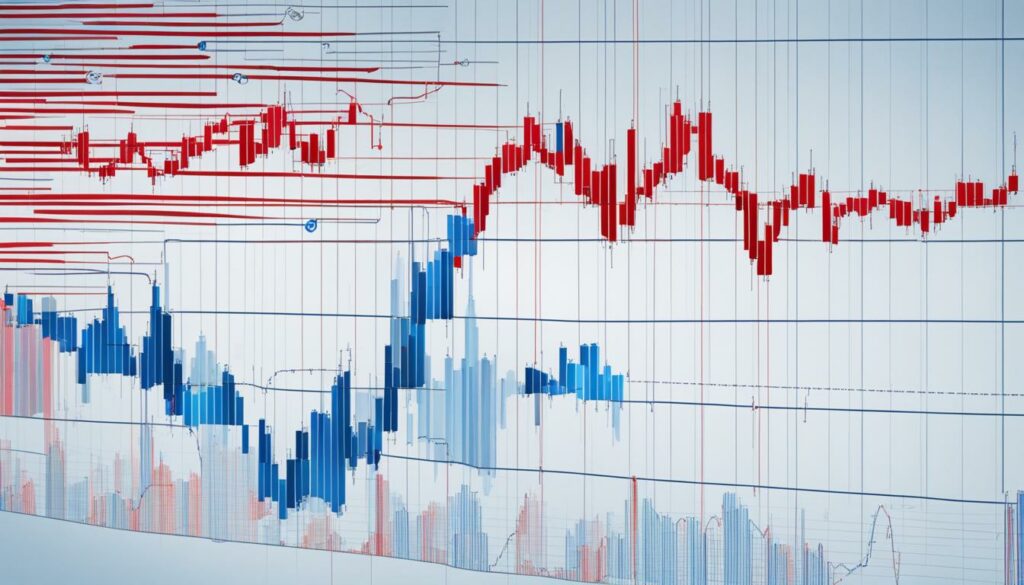Call vs Put: The Ultimate Showdown in Options Trading – Which Side Will You Choose?


Options trading is a complex and dynamic financial market that offers traders a wide range of opportunities. At its core, options trading involves the use of call and put options, which are option contracts that give traders the right, but not the obligation, to buy or sell an underlying asset at a predetermined price, known as the strike price, before a specified expiration date.
Call options provide the holder with the right to buy the asset, while put options give the holder the right to sell the asset. These options have their own unique characteristics and can be used in different trading strategies to manage risk and maximize profit potential.
In this article, we will delve into the key differences between call and put options, their advantages, considerations for risk management, and the importance of trading analysis and investment strategies in making informed decisions.
Key Takeaways:
- Call and put options are option contracts that give traders the right, but not the obligation, to buy or sell an underlying asset at a predetermined price before a specified expiration date.
- Call options are used when traders expect the price of the underlying asset to rise, while put options are used when traders expect the price to fall.
- Call options offer the opportunity to profit from price increases, provide leverage, and can be used to gain exposure to specific sectors or stock indexes.
- Put options offer the opportunity to profit from price decreases, act as insurance against potential losses, and can be used to hedge against downside risk in other investments.
- When deciding between call and put options, it is important to carefully consider risk tolerance, investment goals, and conduct thorough trading analysis.
Key Differences Between Call and Put Options
When it comes to options trading, understanding the key differences between call and put options is essential. Both types of options provide traders with the opportunity to profit from price movements in the underlying asset, but they have distinct characteristics and are used in different market scenarios.
Call options are typically used when traders anticipate an increase in the price of the underlying asset. These options give the holder the right to buy the asset at a predetermined price, known as the strike price, before the expiration date. If the price of the asset rises above the strike price, the call option can be exercised, allowing the trader to purchase the asset at a lower price and potentially profit from the price difference.
Put options, on the other hand, are employed when traders expect the price of the underlying asset to decline. These options give the holder the right to sell the asset at the strike price before the expiration date. If the price of the asset falls below the strike price, the put option can be exercised, enabling the trader to sell the asset at a higher price and capture the price difference as profit.
| Call Options | Put Options |
|---|---|
| Used when anticipating price increases | Used when anticipating price decreases |
| Profit when the underlying asset price is higher than the strike price | Profit when the underlying asset price is lower than the strike price |
| Give the right to buy the asset | Give the right to sell the asset |
The strike price and expiration date are important factors to consider when trading call and put options. The strike price is the price at which the option can be exercised, while the expiration date is the deadline for exercising the option. Additionally, the volatility of the underlying asset’s price can significantly impact the value of both call and put options. Higher volatility generally leads to higher option premiums, as there is greater uncertainty in the future price movements of the asset.
Advantages of Call Options
Call options offer several advantages to traders in the stock market. Firstly, call options provide the opportunity to profit from price increases in the underlying asset. When a trader purchases a call option, they have the right to buy the asset at a predetermined price, known as the strike price. If the price of the asset rises above the strike price, the call option can be exercised, allowing the trader to buy the asset at a lower cost and potentially generate a profit.
Furthermore, call options enable traders to participate in bullish market conditions. If a trader expects a specific stock or stock index to perform well, they can buy call options to gain exposure to that particular sector or index. This creates the opportunity for greater profit potential as the stock or index rises in value. Additionally, call options can be used to trade derivative securities, such as options on exchange-traded funds (ETFs) or futures contracts, providing traders with additional flexibility in their investment strategies.
Another advantage of call options is leverage. The cost of buying a call option is typically lower than buying the actual asset itself. This allows traders to control a larger position in the market with a smaller initial investment. However, it’s important to note that while call options offer the potential for higher returns, they also come with a certain level of risk. If the price of the underlying asset does not rise above the strike price by expiration, the call option can expire worthless, resulting in a loss of the premium paid for the option.
Advantages of Call Options:
- Profit potential from price increases in the underlying asset
- Participation in bullish market conditions
- Exposure to specific stock sectors or indexes
- Trading of derivative securities
- Leverage for greater market exposure
In summary, call options offer traders the opportunity to profit from price increases in the stock market, participate in bullish market conditions, gain exposure to specific sectors or indexes, trade derivative securities, and utilize leverage. However, it’s important for traders to carefully assess their risk tolerance and investment goals before buying call options, as they come with their own set of risks and considerations.
| Advantages of Call Options | Explanation |
|---|---|
| Profit Potential | Allows traders to profit from price increases in the underlying asset |
| Bullish Market Participation | Enables traders to participate in bullish market conditions |
| Exposure to Specific Sectors/Indexes | Provides the opportunity to gain exposure to specific stock sectors or indexes |
| Trading of Derivative Securities | Allows traders to trade derivative securities, such as options on ETFs or futures contracts |
| Leverage | Provides leverage, enabling traders to control a larger position with a smaller initial investment |
Advantages of Put Options
Put options offer several advantages to traders in the options market. By purchasing put options, traders have the opportunity to profit from price decreases in the underlying asset, allowing them to participate in bearish market conditions. Put options act as a form of insurance against potential losses in a portfolio. If the price of the underlying asset declines, the put option can offset those losses, providing downside protection for traders.
Moreover, put options can also be used as a hedging strategy. Traders can utilize put options to hedge against downside risk in other investments, reducing the overall risk exposure of their portfolio. This allows traders to protect themselves from significant losses in the event of an adverse market movement. Put options provide a means to establish a floor on potential losses and limit downside risk in a volatile market.
“Put options offer an attractive profit potential when the price of the underlying asset falls below the strike price. They provide traders with the opportunity to profit from price declines and act as a safeguard against market volatility”
Table: Comparison of Call and Put Options
| Call Options | Put Options | |
|---|---|---|
| Profit Potential | Profit from price increases in the underlying asset | Profit from price decreases in the underlying asset |
| Market Conditions | Bullish | Bearish |
| Downside Protection | No | Yes |
| Hedging | No | Yes |
The advantages of put options make them an essential tool for traders seeking profit potential from price declines and looking to manage risk in a volatile market environment. By understanding the benefits of put options and incorporating them into their trading strategies, traders can enhance their ability to navigate the options market successfully.
Call vs Put: Considerations for Risk Management
When it comes to options trading, managing risk is a crucial aspect that traders need to carefully consider. Both call and put options come with their own set of risks, and understanding these risks is essential for making informed investment decisions.
Key Considerations for Call Buyers:
- Call options provide the right to buy the underlying asset at a predetermined price within a specific time frame.
- The risk for call buyers is limited to the premium paid for the option.
- If the price of the underlying asset does not rise above the strike price, call buyers may lose the premium paid.
- Call options can offer significant upside potential if the price of the underlying asset increases.
Key Considerations for Put Buyers:
- Put options provide the right to sell the underlying asset at a predetermined price within a specific time frame.
- The risk for put buyers is limited to the premium paid for the option.
- If the price of the underlying asset does not fall below the strike price, put buyers may lose the premium paid.
- Put options can act as a form of insurance against potential losses in a portfolio.
Traders should assess their risk tolerance and investment goals before deciding whether to buy call or put options. It is important to consider factors such as market conditions, volatility of the underlying asset, and potential profitability of the options strategies. By carefully evaluating these considerations, traders can effectively manage risk and make informed decisions in the options market.


| Considerations | Call Options | Put Options |
|---|---|---|
| Potential for Upside Gains | High | Low |
| Potential for Downside Protection | Low | High |
| Risk for Buyers | Premium Paid | Premium Paid |
| Risk for Sellers | Unlimited | Strike Price – Premium Received |
Trading Analysis: Evaluating Call and Put Options
When it comes to options trading, conducting thorough trading analysis is essential for making informed investment decisions. Evaluating call and put options involves assessing market conditions, analyzing the volatility of the underlying asset, and implementing options strategies that align with your trading goals. By considering these factors, you can effectively navigate the options trading landscape and work towards achieving your investment objectives.
One key aspect of trading analysis is understanding the stock market and its dynamics. Keeping an eye on market trends, news, and economic indicators can provide valuable insights into potential trading opportunities. Technical analysis, such as studying price charts and using indicators, can aid in identifying entry and exit points for call and put options.
Another crucial consideration is the evaluation of options strategies. These strategies can involve a combination of call and put options, such as buying a straddle or a strangle, to take advantage of potential market volatility. Implementing options strategies requires careful analysis and an understanding of the risk-reward profile of each strategy.


Investment Strategies: Choosing between Call and Put Options
When it comes to investment strategies in the options market, traders have to make a crucial decision: should they choose call options or put options? This choice depends on a variety of factors, including the trader’s outlook on the underlying asset, risk tolerance, and market analysis.
For traders who believe that a particular asset will experience price increases, buying call options can be a profitable strategy. Call options provide the opportunity to participate in bullish market conditions and profit from upward price movements. On the other hand, traders who anticipate price decreases in a specific asset may prefer to buy put options. Put options allow traders to profit from bearish market conditions and provide a form of insurance against potential losses in their portfolios.
Furthermore, traders can explore various options strategies to maximize their investment strategies. One such strategy is buying both call and put options to create a straddle or strangle strategy. These strategies take advantage of potential market volatility, offering the potential for profit regardless of whether the price of the underlying asset goes up or down. Effective risk management is essential when using these strategies to ensure that potential losses are mitigated.
Risk Management: A Key Consideration
Managing risk is a critical aspect of options trading, and it’s important for traders to understand the risks associated with both call and put options. Call buyers risk losing the premium they paid for the option if the price of the underlying asset does not rise above the strike price. Similarly, put buyers risk losing the premium if the price of the underlying asset does not fall below the strike price. Traders should carefully assess their risk tolerance and investment objectives before deciding whether to buy call or put options.
In summary, choosing between call and put options requires careful consideration of investment strategies and risk management. Traders need to evaluate their outlook on the underlying asset, risk tolerance, and market analysis to make an informed decision. By understanding the advantages and considerations of each option type, traders can effectively navigate the options market and work towards achieving their investment goals.


Conclusion
Call and put options offer unique opportunities for traders in the options market. Understanding the differences between call and put options, as well as their advantages and considerations for risk management, is essential for making informed investment decisions.
Traders should conduct thorough trading analysis and evaluate their investment strategies to determine whether call or put options are the right fit for their trading goals. By carefully considering various factors such as market conditions, volatility, and risk tolerance, traders can effectively utilize call and put options to navigate the options trading landscape and work towards achieving their investment objectives.
Ultimately, the choice between call and put options will depend on the trader’s investment strategies, risk appetite, and market analysis. Whether a trader is optimistic about price increases or anticipates price decreases, call and put options can provide opportunities to profit and manage risk in the dynamic world of options trading.
FAQ
What are call and put options?
Call and put options are financial derivatives that give traders the right, but not the obligation, to buy or sell an underlying asset at a predetermined price before a specified expiration date.
How do call options work?
Call options give the holder the right to buy the underlying asset at a predetermined price before the expiration date. They are typically used when traders expect the price of the asset to rise.
How do put options work?
Put options give the holder the right to sell the underlying asset at a predetermined price before the expiration date. They are typically used when traders expect the price of the asset to fall.
What is the strike price?
The strike price is the price at which the option can be exercised.
What is the expiration date?
The expiration date is the date at which the option contract expires.
What are the advantages of call options?
Call options provide the opportunity to profit from price increases in the underlying asset, offer leverage, and can be used to gain exposure to specific sectors or stock indexes.
What are the advantages of put options?
Put options provide the opportunity to profit from price decreases in the underlying asset, act as a form of insurance against potential losses, and can be used to hedge against downside risk in other investments.
What are the risks associated with call options?
Call options carry the risk of losing the premium paid for the option if the price of the underlying asset does not rise above the strike price.
What are the risks associated with put options?
Put options carry the risk of losing the premium paid for the option if the price of the underlying asset does not fall below the strike price.
How should I choose between call and put options?
The choice between call and put options depends on your investment strategies, risk tolerance, and market analysis. Traders who are bullish on an asset may prefer call options, while traders who are bearish on an asset may prefer put options.




